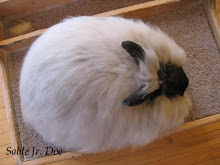As gas prices go up and the price of everything seems to be rising each day, it is a good idea to look over our rabbitry routine periodically to see if we can cut costs:).
As we have all noticed, feed prices go up when gas costs go up. Lately, feed prices have skyrocketed, which makes any breeder pause to think about how their costs can be contained. Since feed is by far the most expensive ingredient in raising rabbits, it is the first factor to consider.
Quality angora feed is not cheap, but there are things we can do to lower the price:
1) Order it by the ton. A ton of feed sounds overwhelming, but when you consider the fact that a rabbitry of 40 or more adults including nursing does and babies can easily polish off 4 or more 50 lb. bags of feed a week, it becomes a logical and attractive option. A ton of 40 lb. bags of feed amounts to 50 bags. A ton of 50 lb. bags equals 40 bags. If you order a ton of feed straight from a company you will not only get it at the wholesale price, but even with the cost of shipping you may find that you can save 5$ or more per bag under the cost at your local feed store. Add this benefit to the fact that you are eliminating a middle man who may a) be storing your feed improperly, b) forgetting to order at the right time thus leaving you hanging at the worst possible moment, and c) neglecting to keep track of expiration dates. Ordering feed yourself often makes it possible to get a batch right after it has been milled, and even if you do not have anyone to share a ton with (another breeder to split it with you, etc.), you would still have a good chance of using up the full amount by the time it expired. 1/2 tons are also available to order from most companies, but shipping costs are often the same and it is usually more economical to order the full ton.
2) Choose a less expensive feed. Though you would never want to use a feed with poor quality ingredients, there are certainly variations in price between most of the major brands. Depending on where you live, feeds which are manufactured nearby are going to be cheaper (and fresher) than brands which are milled far away. Also, some brands are available in 50 lb. bags while others are available in 40, making it smart to calculate cost effectiveness.
3) Use a lower protein feed for younger rabbits and a higher protein one for adults, especially if a lower version in the same feed line is cheaper. Angora juniors, for example, are not typically competitive on the show table and baby wool is not of great value to the spinner either, so it does not necessarily pay to feed babies a top of the line feed with a high protein level to promote wool growth. Most major feed lines offer an assortment of feed preparations with varying protein levels. A Standard 16% (or even 15%) feed will work very well for babies up to 4 months, and may better safeguard gut health since juniors of 14 weeks and below are more susceptible to enteritis.
4) Cut down the number of rabbits in your herd. This can be difficult if you are trying to maintain a gene pool of a certain size or are working on a project which requires frequent, heavy breeding. However, if cutting back means the difference between continuing or going out of rabbits altogether, you will simply have to prioritize. If you are forced to downsize, one option to consider is to take on a partner who has similar breeding goals and animals of similar quality who would be willing to trade rabbits and breedings to keep the line/gene pool healthy. Since agreements of this nature can often run into conflict, it is important to partner with someone who shares your breeding goals and is someone with whom you get along well.
More again next time as I add to this topic and try listing ways to save $$ on hay, supplements, meds, tools, cage equipment, and so on. Also, I will add a list at the end to suggest ways of bringing money in while raising rabbits. Rabbits are not typically known as money makers, but it is certainly possible to make enough profit while raising them (particularly angoras) to cover the cost of feed and other needs.
Have a great week!:-)
Tuesday, May 17, 2011
Subscribe to:
Post Comments (Atom)























1 comment:
Hello,
You were recommended as a French Angora breeder from "The Brown Rabbit", but I cannot get your "contact" tab to work. I am interested in purchasing a REW French Angora as a pet and wooler and wondered where your rabbitry is located? Do you attend Southeaster Animal Fiber Fair?
Please contact me at lsylte@gmail.com
Thank you,
LaRie
Post a Comment